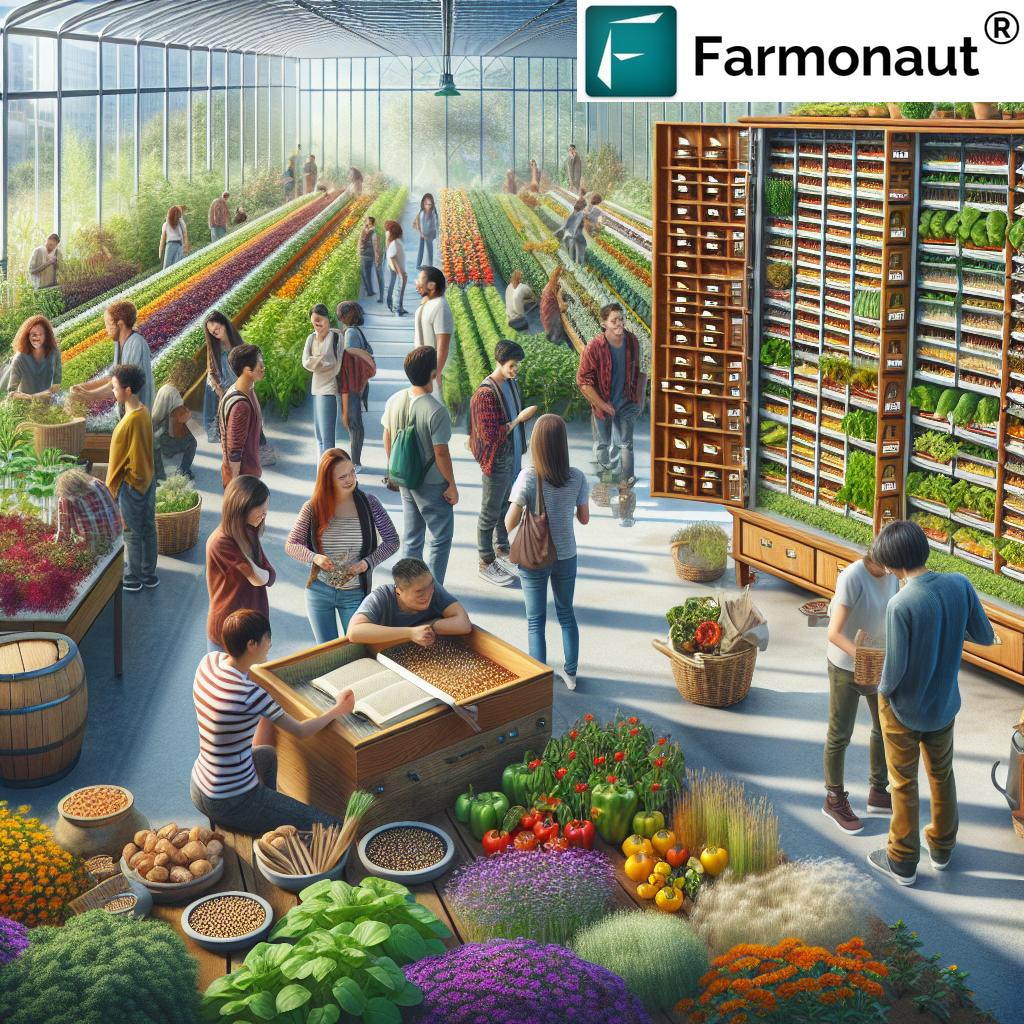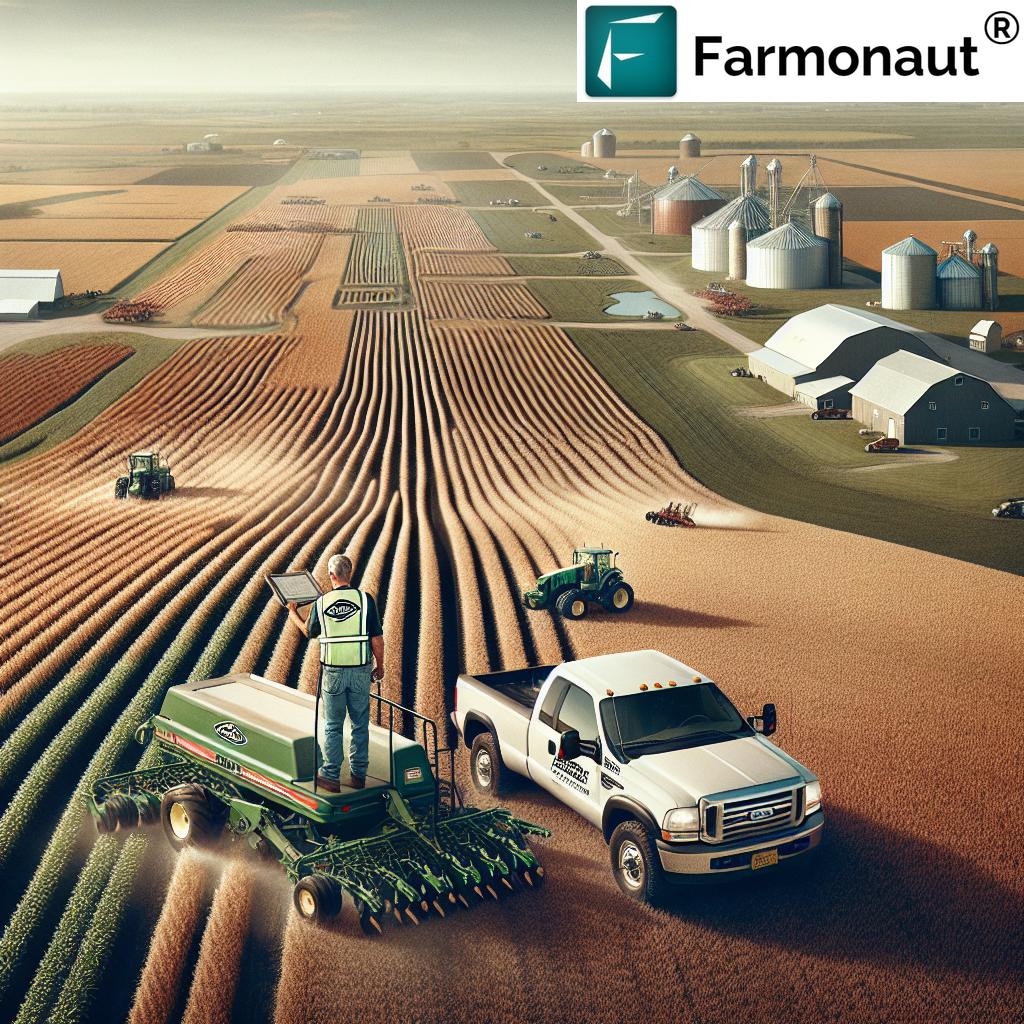Agriculture Loans Twin Bridges: 2025 Market Game-Changers
Table of Contents
- Introduction: Why Agriculture Loans and Bridges Matter in 2025
- Trivia: Market Growth Boosts
- Agriculture Loans Twin Bridges: Pivotal Financial Tools in Rural Growth
- Twin Bridges Infrastructure: Connecting Rural Innovation
- Central Role of Local Markets Near Bridges
- Regional Hubs: Cambridge, Ross Bridge, and Beyond
- Bridgeport Farmers Market: Year-Round Market Resilience
- Comparative Impact Analysis Table: 2025 Agriculture Loan Options
- Farmonaut Technology: Driving Sustainability and Insightful Decisions
- Trivia: Infrastructure Impact
- 2025 and Beyond: Integrating Loans, Bridges, and Markets for Sustainable Development
- FAQ: Agriculture Loans, Markets, and Infrastructure
- Conclusion: The Future of Sustainable Rural Economies
“**In 2025, agriculture loans in Twin Bridges are projected to boost local produce markets by 35%.**”
Introduction: Why Agriculture Loans and Bridges Matter in 2025
In 2025, the intersection of agriculture loans Twin Bridges, critical bridge infrastructure, and regional local markets continues to play a transformative role in the advancement of rural economies and sustainable farming communities. As the world faces increasingly unpredictable climate and economic headwinds, these essential drivers enable farmers and local communities to thrive by ensuring access to affordable credit, robust transportation links, and dynamic farmers markets such as New Bridge Farmers Market, Ross Bridge Farmers Market, and Bridgeport Farmers Market.
The synergy between infrastructure—especially bridges—and agriculture loans fundamentally strengthens the supply chain for fresh produce. This comprehensive analysis explores how, in 2025 and beyond, these elements empower farmers, support local food systems, and drive rural development, with a special focus on regions like Twin Bridges, Cambridge, and Ross.
Agriculture Loans Twin Bridges: Pivotal Financial Tools in Rural Growth
Agriculture loans in Twin Bridges remain indispensable for farmers seeking to modernize operations, adopt sustainable technologies, and drive improved crop yields. As economic and climate uncertainty escalates, especially in 2025, access to affordable credit is a make-or-break factor for both small and medium-scale farmers in the region.
- Credit Accessibility: Affordable loans enable investment in essential resources (seeds, fertilizers, irrigation systems, machinery).
- Operational Resilience: Loans reduce logistical hurdles, allowing timely delivery of produce to markets by leveraging improved bridge infrastructure.
- Climate Adaptation: Farm credit supports technologies that address unpredictable weather, including sustainable farming systems and precision agriculture.
- Modernization: Enables adoption of new practices such as AI-guided irrigation and environmentally-friendly fertilizers to ensure the sector’s resilience.
With loan programs tailored to the Twin Bridges region, local farmers are better positioned to overcome challenges, improve post-harvest handling, and access the infrastructure required for efficient transport of goods.
Modern Loan Structures: 2025 Focus
The 2025 loan landscape in agriculture Cambridge, Twin Bridges, and beyond incorporates low-interest programs and environmentally-incentivized lending. Examples include:
- Green Loans: Lower interest rates for farmers implementing sustainable practices and investing in eco-friendly systems.
- Technology-Linked Credit: Financing for precision agriculture and AI-driven infrastructure.
- Weather Resilience Loans: Focused on irrigation and climate-adaptive infrastructure (e.g., reinforcing farm structures).
- Community Infrastructure Loans: Supporting projects near vital transport nodes such as bridges and local farmer markets.
Loan providers also incorporate satellite-based verification (learn more about Farmonaut Crop Loan & Insurance Technology), improving application transparency and making the process faster and more reliable.
Twin Bridges Infrastructure: Connecting Rural Innovation
While financial support is essential, robust infrastructure—particularly bridge systems in and around Twin Bridges—is the backbone of rural economic advancement. Bridges are more than structural assets: they form a vital connection in the agricultural supply chain, linking farmers to markets—from New Bridge Farmers Market to Ross Bridge Farmers Market, and more.
- Reduced Distance and Food Miles: Direct connections from remote farms to urban consumer hubs lower transportation costs and cut food miles.
- Year-Round Reliability: Modern and resilient bridges ensure timely delivery regardless of weather challenges (e.g., flooding, storms), preventing post-harvest losses and spoilage.
- Economic Multiplier Effect: Enhanced infrastructure encourages investments in agribusiness, logistics, and rural retail.
- Community Engagement: Improved connectivity fosters engagement between farmers, buyers, and the broader rural community, unlocking social and economic benefits.
Investments in critical bridges are poised to dramatically improve access to market locations, driving upward trends in local food production and fair pricing.
Access our satellite-driven agricultural monitoring tools via Web and Mobile to optimize farm management for 2025 and beyond.
Developers and agribusinesses can integrate Farmonaut’s data and insights via our API or get more information from our API Developer Docs.
Central Role of Local Markets Near Bridges
Strategically placed farmers markets—especially those near major bridges—create centralized nodes where farmers sell produce directly to consumers. The New Bridge Farmers Market, for example, exemplifies how infrastructure development works hand-in-hand with market vitality in 2025:
- Community Hubs: Markets like New Bridge Farmers Market become gathering points for both producers and buyers, making fresh food more accessible for the public.
- Price Transparency: Shortened supply chains mean farmers receive fair prices, while consumers pay less for fresh, high-quality food.
- Diversified Offerings: Accessible infrastructure attracts specialty vendors in organic, sustainable, and value-added agricultural products.
- Agri-Tourism: Convenient market access invites urban visitors, stimulating local rural economies through tourism and hospitality.
By reducing logistical barriers using strategic bridge placements and modern transport connections, local food markets such as Ross Bridge Farmers Market serve as engines for sustainable growth.
Regional Hubs: Cambridge, Ross Bridge, and Beyond
Regions like Cambridge and Ross Bridge illustrate how the combination of financial support, upgraded infrastructure, and dynamic local markets create resilient and progressive agricultural communities.
Agriculture Cambridge: Enhanced Connectivity and Sustainable Growth
Agriculture Cambridge is renowned across the region for its rich farmland and progressive practices. In 2025, Cambridge farmers rely on improved road and bridge networks to:
- Efficiently distribute produce to urban centers (improving both speed and reliability, especially for perishables).
- Attract new agribusiness investments through stable logistics and market access.
- Participate in environmental programs that incentivize sustainability (learn more about carbon footprinting solutions that help monitor and reduce emissions).
- Offer farm-to-table experiences appreciating the origins of local food.
Ross Bridge Farmers Market: Innovation in Rural Market Access
Ross Bridge Farmers Market benefits directly from well-maintained bridges and highways that link rural growers to both local buyers and urban retailers or restaurants. This proximity and connectivity enables:
- Faster access for farmers to reach a broad customer base.
- Year-round engagement with the community, despite unpredictable weather.
- Vendor diversity, driving innovation and supporting organic or specialty produce.
- Education and collaboration hubs where best agricultural practices and sustainability are shared.
The area is a model for local economic resilience and market-driven growth—underpinned by a strategic blend of finance, infrastructure, and farming know-how.
Bridgeport Farmers Market: Year-Round Market Resilience
Bridgeport Farmers Market, uniquely positioned with robust bridge infrastructure, delivers year-round reliability for farmers’ market operations. In 2025, regional investments focus on:
- Reinforcing bridges to withstand extreme weather events, a growing risk under modern climate trends.
- Guaranteeing market access throughout all seasons so that farmers can deliver goods and receive vital supplies without delay.
- Minimizing post-harvest losses by ensuring timely transport regardless of weather or logistics disruptions.
- Supporting supply chain transparency—see how real-time resource monitoring and traceability technology can assure freshness and food safety for consumers.
Comparative Impact Analysis Table: 2025 Agriculture Loan Options
Examine and compare the estimated impacts of leading agriculture loan programs, bridge infrastructure developments, market access improvements, rural economic growth forecasts, and sustainability benchmarks for Twin Bridges in 2025.
| Loan Type / Locality | Estimated Interest Rate (%) | Twin Bridges Project Influence | Market Accessibility Improvement (%) | Expected Rural Economic Growth (%) | Sustainability Score (1-10) |
|---|---|---|---|---|---|
| Standard Rural Loan – Twin Bridges | 4.1 | Medium | 25 | 15 | 7 |
| Green Loan Program – New Bridge Market Vicinity | 3.4 | High | 40 | 22 | 9 |
| Tech/AI-Linked Loan – Cambridge | 3.8 | High | 38 | 20 | 10 |
| Weather Resilience Loan – Ross Bridge Area | 4.2 | Medium | 30 | 18 | 8 |
| Community Infrastructure Loan – Bridgeport | 4.0 | High | 37 | 23 | 9 |
Farmonaut Technology: Driving Sustainability and Insightful Decisions
As advocates for sustainability and innovative growth, we at Farmonaut empower agricultural communities and financial institutions with data-driven solutions:
- Satellite-Based Monitoring: Monitor crop health, soil quality, and bridge/road infrastructure using affordable, real-time imaging.
- AI Advisory Systems: Our Jeevn AI platform offers weather forecasts and tailored strategic advice to farmers, essential for maximizing productivity and minimizing risks from unpredictable climatic conditions.
- Blockchain Traceability: We enable transparent supply chains for agricultural produce, adding value to markets and supporting consumer trust in local food.
- Fleet & Resource Management: Optimize farm machinery and transportation logistics, reducing costs for goods moving from field to market—visit our fleet management solutions.
- Environmental Tracking: Allow for ongoing carbon footprint monitoring in farming and bridge construction, driving eco-friendly regional development.
Our goal: Make satellite-driven agricultural insights affordable and accessible—empowering every stakeholder in the Twin Bridges region (and beyond) to drive resilient, sustainable development.
Ready to scale your farm? Explore large scale farm management with state-of-the-art monitoring via our online platform and dedicated apps.
“**Rural infrastructure projects, including new bridges, may increase sustainable farm access routes by 28% next year.**”
2025 and Beyond: Integrating Loans, Bridges, and Markets for Sustainable Development
The convergence of affordable agricultural loans, resilient bridge infrastructure, and dynamic farmers markets is fundamentally reshaping the Twin Bridges sector—and holds a blueprint for sustainable rural development worldwide. The Twin Bridges region, agriculture Cambridge, Ross Bridge Farmers Market, and Bridgeport Farmers Market all serve as real-world illustrations of what coordinated financial and infrastructure investments can accomplish.
- Increased Productivity: Farmers can modernize, optimize, and expand their operations with reliable credit and supply chain connections.
- Resilience Amidst Climate Challenges: Robust infrastructure and technology-driven farming practices protect against unpredictable weather and disruptions.
- Enhanced Market Opportunities: Strong transport links and direct-to-consumer markets improve pricing, reduce losses, and grow rural incomes.
- Sustainability at Scale: Integrated tracking and monitoring lead to lower resource use, decreased carbon emissions, and healthier environments.
Crucially, policy frameworks in 2025 are increasingly aligning financial incentives with infrastructure building, creating comprehensive solutions for communities like Twin Bridges and the wider Cambridge area.
To benefit from these advances, farmers and rural economic actors in Twin Bridges and similar regions must continuously improve their practices, engage with technology (for example, via Farmonaut’s remote farm monitoring tools), and participate in local infrastructure planning.
FAQ: Agriculture Loans, Markets, and Infrastructure
1. What are the main types of agriculture loans available in Twin Bridges in 2025?
- Standard Rural Loans: Focused on general development and input purchases.
- Green Loans: Encourage adoption of sustainable practices through lower rates.
- Tech-Linked Loans: Support AI, precision ag, and digital upgrades.
- Weather/Infrastructure Loans: For climate adaptation and community improvements.
2. How do new and enhanced bridges impact local farming communities?
By providing year-round reliable access to urban and local markets, bridges reduce transport times, decrease product spoilage, lower logistics costs, and create new opportunities for direct sales and agri-tourism.
3. In what ways do farmers markets like New Bridge Farmers Market benefit the regional food system?
They foster engagement between farmers and consumers, ensure fresh produce at fair prices, drive food traceability, and increase local revenues—while minimizing food miles and supporting sustainable practices.
4. What technologies does Farmonaut offer for farmers and agri-financial institutions?
We provide real-time satellite monitoring, AI-powered guidance, blockchain-based traceability, and resource management tools that:
- Improve productivity and yields,
- Make supply chains transparent,
- Help monitor environmental impact, and
- Allow for the efficient management of land and equipment.
5. Are there special incentives for sustainable practices or eco-friendly infrastructure?
Yes! Many 2025 agricultural loans and infrastructure programs include incentives for those adopting carbon tracking, sustainable farming systems, or resilient bridge and road construction. Learn more about carbon footprint monitoring solutions provided by Farmonaut.
6. What is the benefit of using an integrated monitoring system like Farmonaut’s?
It allows farmers, businesses, and lenders to remotely monitor fields, resources, and infrastructure from anywhere (web, Android, iOS), facilitating better decisions, insurance, and reporting. It saves time, reduces risks, and maximizes efficiency.
Conclusion: The Future of Sustainable Rural Economies
In the decade ahead, integrated investment in agriculture loans Twin Bridges, resilient bridge infrastructure, and thriving local markets like New Bridge Farmers Market, Ross Bridge Farmers Market, and Bridgeport Farmers Market is shaping a more sustainable, resilient agricultural sector. Financial inclusion, reliable transportation, and strong community engagement are the pillars of a new rural reality, grounded in 2025 best practices.
As a technology partner, we at Farmonaut stand committed to offering practical, affordable satellite-based insights and resource management tools. By embracing innovation and data-driven decision-making, the Twin Bridges region and similar rural hubs across the globe can achieve greater productivity, environmental stewardship, and economic growth for the next generation.
For actionable insights, remote crop and infrastructure monitoring, and to arm your rural enterprise with futuristic tools, explore our app or consult our dedicated platform—putting tomorrow’s farming innovation at your fingertips, today.












